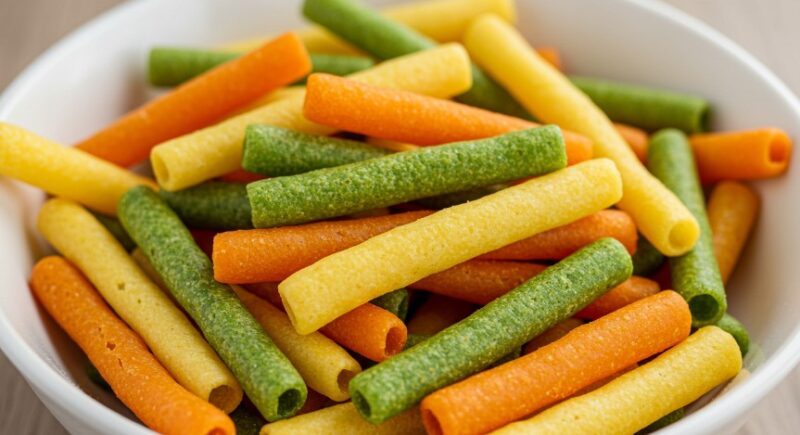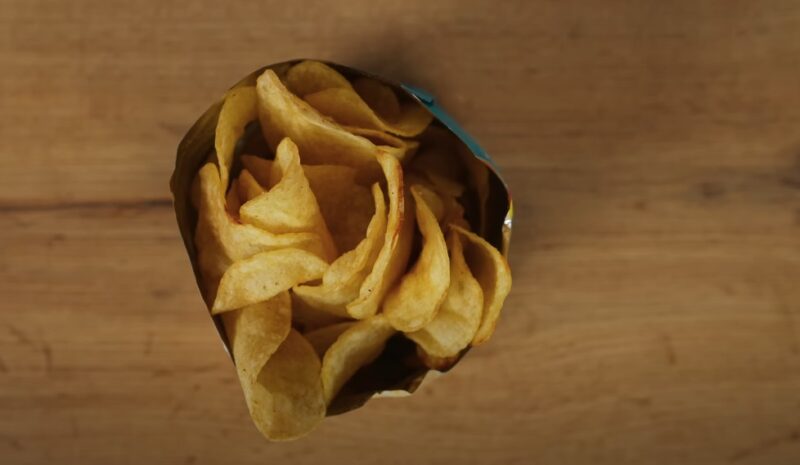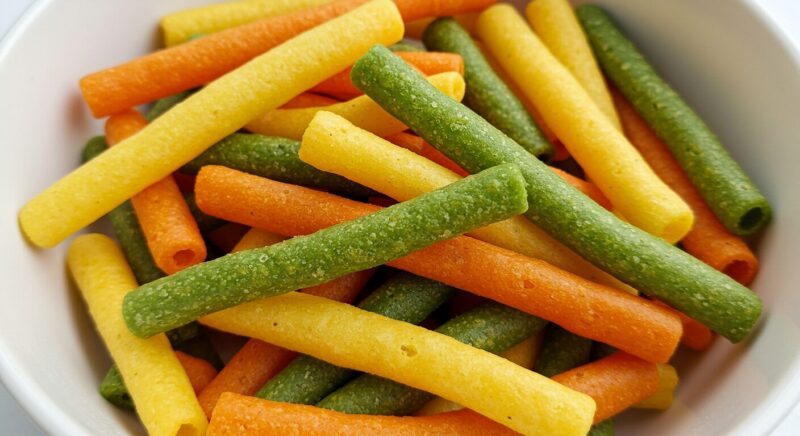How Are Veggie Straws Made? A Behind-the-Scenes Look
Crunchy, lightly seasoned, and widely considered a more wholesome option than traditional chips, veggie straws have found their way into many snack cabinets.
People who enjoy them might be curious about the creation process or the actual ingredients hidden within those colorful, airy tubes. Let’s check out how they are produced and what that implies for dietary needs.
A Quick Glance at Key Ingredients
View this post on Instagram
Many shoppers spot veggie straws in vibrant packaging and assume they’re made entirely of fresh produce.
It’s beneficial to know the core elements involved, since the final product might surprise those who picture raw carrots and spinach going straight into a fryer. A few primary items power the entire process:
- Potato Derivatives: Potato starch and potato flour form the base, shaping the signature texture and providing a neutral canvas for other ingredients.
- Powders From Vegetables: Tiny amounts of tomato paste, spinach powder, or beetroot powder add the iconic green, orange, or reddish tinge. These powders supply modest taste but lack many vitamins and minerals found in whole produce.
- Oils: Options like canola, safflower, or sunflower oil handle the cooking phase. The choice of oil can affect flavor profile, mouthfeel, and nutritional components.
- Seasonings: Salt is often the star flavor enhancer, but other herbs and spices may join the mix. Sodium content can get high, so it’s worth scanning the nutrition label if salt intake is a concern.
The Production Steps
Ever wondered how a pile of dry powders transforms into crunchy sticks? The manufacturing journey brings together modern technology and food science.
1. Mixing the Base
Dry ingredients—potato starch, potato flour, and powdered vegetables—meet seasonings in large industrial mixers.
These giant machines spin at high speed, ensuring an even consistency throughout. Manufacturers aim for a smooth blend capable of holding its shape after the next phase.
2. The Extrusion Process
Once the mixture is uniform, it’s moved into an extruder. Picture a sizable piece of equipment that applies intense heat and pressure, then pushes the mix through narrow openings.
That step yields the instantly recognizable straw-like form. Adjusting pressure and temperature allows operators to control thickness, crispness, and even shape to some degree.
3. Cooking Approaches
Shaped straws then encounter frying or baking, two distinct methods with different impacts on fat content and taste:
- Frying: Submerging the snack in heated oil produces a golden, crunchy exterior. Since frying immerses the straws entirely, fat absorption is higher.
- Baking: Hot air circulates around the snack, drawing out moisture and crisping the exterior. Fat content tends to be a bit lower, though some oil may still be involved for texture.
4. Seasoning on the Surface
Freshly cooked straws often get another dusting of spices and salt once they emerge from the cooker. This final touch ties the whole snack together and seals in flavor.
5. Packing It Up
When the straws cool down, they move along a conveyor belt toward packaging stations. Air-tight bags or sealed containers preserve freshness and protect the product in transit.
After that, veggie straws are ready to head out to grocery stores and, eventually, pantry shelves.
Crunchy Yet Questionable?

Labels often show pictures of tomatoes or spinach, and marketing may hint at abundant veggie goodness in every bite. Reality can be a little different, so it’s wise to check a standard serving’s nutrition facts:
- Caloric Content: Roughly 130 calories per 28 grams (about one ounce).
- Total Fat: Around 7 grams, including about 1 gram of saturated fat.
- Sodium: Up to 220 milligrams of sodium in a single serving, which can add up fast across multiple handfuls.
- Fiber and Protein: Generally below 1 gram each, contributing little to satiety.
Those stats highlight the gap between an entire carrot and a processed snack. Though veggie powders bring flavor and color, the end product doesn’t deliver many of the original nutrients.
Factors to Keep in Mind
Processing Impacts Nutrient Density
Being highly processed strips away beneficial fiber, vitamins, and minerals found in whole vegetables.
Watch Out for Excessive Sodium
High salt content is a concern for quite a few snack foods, and veggie straws are no exception. Excess sodium can have harmful effects on blood pressure if eaten in large quantities.
Individuals tracking salt intake might opt for reduced-sodium options or smaller serving sizes.
Limited Satiety
Snacks that lack fiber and protein tend to leave people craving more. Veggie straws generally fall into that category. It’s easy to go through multiple servings without realizing it, so portion control can be a lifesaver for anyone watching calorie intake.
Comparing Snack Choices

Those looking for a crunchy treat face countless options in stores: potato chips, popcorn, tortilla chips, baked crackers, and beyond. Most veggie straws are gluten-free and often appear under the “healthier alternatives” umbrella, but how do they really stack up?
- Potato Chips: Traditional chips can have a similar fat content and may be equal in sodium. However, chips might be made from whole slices of potato instead of processed starches.
- Popcorn: When air-popped (or lightly seasoned), popcorn often supplies fiber and lower overall calories than fried snacks.
- Baked Crackers: Some crackers feature whole grains that give a bit more fiber and protein than veggie straws.
- Raw or Roasted Vegetables: Actual veggies bring vitamins, minerals, and fiber. Roasted chickpeas or kale chips can also offer a nutritious crunch with fewer empty calories.
All snacks vary based on ingredients, methods of preparation, and portion sizes. Reading labels can uncover beneficial information, helping individuals make choices that align with personal health goals.
Final Thoughts
Veggie straws emerged as a creative idea for bridging the gap between potato chips and fresh produce, yet they aren’t the golden ticket to nutritional excellence. They’re fried or baked bits of processed ingredients shaped to look appetizing and distinct.
They can certainly be fun to munch on in moderation, but relying on them for a robust dose of vitamins and minerals would be unwise. Adding more whole, unprocessed foods to a diet brings undeniable health benefits, from better nutrient intake to higher fiber content.
Enjoying veggie straws here and there won’t derail a balanced diet, but genuine vegetables remain the best source of nutrition. Next time a snack craving hits, feel free to reach for that bag on occasion, but consider pairing it with fresh produce or a protein-packed dip.

